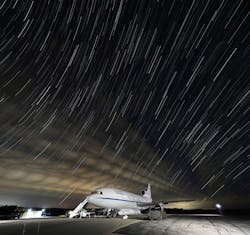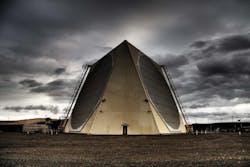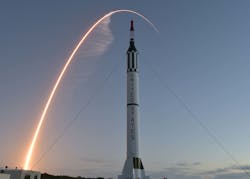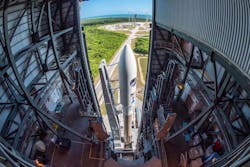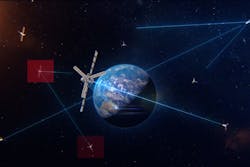Space Force zeroing-in on satellites, launch vehicles, radar, electro-optical sensors, communications, and cyber security
By Megan Crouse
NASHUA, N.H. - The newest branch of the U.S. military in residence at the Pentagon, the U.S. Space Force. operates at the upper limits of human territory. Its jurisdiction starts 60 miles above the surface of the Earth, extending outward from there.
Pundits have debated whether the Space Force is a necessary change. Could the Air Force not cover more space-based assets like satellites and vehicles? The answer is complicated, especially in the context of the Space Force’s history of growing out of Air Force ventures.
For industry, the debate also goes on: will this benefit only the few large government space vendors in place now, or benefit industry as a whole? Many are taking a look at the enabling technologies behind the Space Force and how they might effect aerospace engineering, budgets and projects.
Past conflicts and responsibilities
In the Space Force’s own words: “Space affects almost every part of our daily lives and is fundamental to our economic system. For example, satellites not only power the GPS technology that we use daily, but allow us to surf the web and call our friends, enable first responders to communicate with each other in times of crisis, time-stamp transactions in the world financial market, and even allow us to use credit cards at gas pumps.”
The Space Force’s jurisdiction covers the military use of satellites, which includes Global Positioning System (GPS), intelligence satellites, hypersonic missiledetection, communications, remote sensing, radar, and space vehicles. As well as handling physical threats, a component of the Space Force also is responsible for the digital security of military space systems.
The Space Force operates as part of the Department of the Air Force, which in 2021 called for a budget supporting about 6,400 military and 3,600 civilian personnel. The transition is ongoing as bases and personnel fall on either side of the Air Force/Space Force line or somewhere in between. Specifically, the Space Force grew out of the Air Force Space Command, which has a storied history since its inception in 1982. The Space Command also operated in the realms of satellites, launch vehicles, and early warning ballistic missile systems — particularly radar.
Three distinct military space efforts come under the umbrella of the U.S. government as of 2021. The Space Force is a distinct group from the U.S. Space Command, a division of the Air Force to which the Space Force could provide troops if needed. A third, smaller group, the Space Development Agency, oversees the creation of the network of tracking satellites known as the National Defense Space Architecture. It is further distinct from the National Reconnaissance Office (NRO), which is still the agency with the most jurisdiction over U.S. intelligence satellites. Naturally, all of these groups will cooperate and communicate to a degree. The Space Force is still responsible for only about half of all U.S. military launches and satellites.
Naturally, even the Space Force’s leaders have an Air Force connection. Chief of Space Operations and General Jay Raymond currently oversees the Space Force. He was appointed by former President Donald Trump and changed titles from his previous role as commander of the Air Force Space Command. Chief Master Sgt. Roger Towberman serves as the senior enlisted advisor.
So, where do these personnel (officially called Guardians) actually work? As in other elements of its creation, the Space Force will use Air Force bases to set up its operations. First, the government re-named Cape Canaveral Air Force Station and Patrick Air Force Base as Space Force bases in December 2020. More bases followed suit — in particular those with relevant capabilities and specialities, such as the former Ka’ena Point Satellite Tracking Station, Hawaii.
Budgets and contracting
More important to industry is how the Space Force’s creation will change existing defense projects or affect contract proposals. In the 2020 Defense Space Strategy, U.S. Department of Defense (DOD) officials vowed that the Space Force would have cooperation with industry as a guiding principle. Industry also can expect to keep eyes out to see to what degree a the administration under President Joe Biden will embrace the Space Force established by the previous president.
For a small service, the Space Force has a very large research and development appropriation for its size: $10.3 billion in 2021. According to a Center for Strategic & International Studies report, the majority (35 percent, or $3.6 billion) of that money is assigned to classified matters. However, knowing the scope of the branch means we can make some educated guesses that it also will concern missile-warning systems, satellite constellations, communications, military space planes, and digital and physical security for same.
2021 was the first year the Space Force had complete independent control of its own budget process, which led to some disagreements among lawmakers. The Biden administration is seeking a budget of $17.4 billion in 2022, about $2 billion more than the previous year. That additional money will go to keep the U.S. on an even playing field with Chinese and Russian anti-satellite weapons. Some members of the House Armed Services Committee said this budget did not focus enough on new defenses that can keep expensive satellites safe.
“We can leverage a burgeoning commercial industry,” said Space Force Chief of Space Operations Gen. John Raymond. “The other thing that we need to do is to leverage our international partners to a greater extent.”
In 2021 Raymond linked public excitement for commercial space flight to increased interest in Space Force recruitment. What about within industry?
In the beginning, the narrative went that Space Force might provide an in for smaller companies. “Because [the Space Force] will be a smaller service with fewer resources, it may be more dependent on industry for technical advice and policy input,” Loren Thompson of Lexington Institute, which receives funding from defense contractors, told the Washington Post in 2018. “[It] would likely be more of a creature of industry than if the Air Force were kept intact.”
Other opinions differ. “It’s too soon to tell if there’s any change yet,” says Todd Harrison, director of Defense Budget Analysis and the Aerospace Security Project at the Center for Strategic and International Studies (also funded in part through the industry). “The Space Force acquisition enterprise was just inherited from the Air Force.”
Therefore, the force is still moving over personnel who may have rotated in and out of space jobs throughout their careers. So, the field of space acquisitions is still being created.
The Space Defense Agency (SDA) mentioned above also could be of interest for industry. Although the agency is small, its roadmap includes launching an increasing number of defense-supporting satellites. Therefore, as a DOD feature writer says, “the SDA is relying heavily on industry and is encouraging new ways of thinking within the industry about how to provide capabilities to the government. Instead of the kinds of big contracts that end up producing things like new airplanes or carriers, SDA wants the industry to understand that there will be an ongoing market for satellites — lots of them.”
On the macro level, that means launches. The Space Force awarded a contract in 2020 to United Launch Alliance (ULA), a joint Boeing/Lockheed Martin effort, to launch 60 percent of the missions on its newest launch procurement contract. The remaining 40 percent went to SpaceX.
But these are companies that had existing relationships with the Air Force. What about new opportunities?
New opportunities ... eventually
“We’re seeing billions of dollars of new money in commercial space, driving innovations in small satellites and launch vehicles,” said Carissa Bryce Christensen,CEO of Bryce Space and Technology, at the Future of War conference in 2019. “That community is not well connected to the military and the intelligence community.” She suggested the Space Force was an opportunity to change that.
Over the last two years, has that actually happened? Not yet, but changes in the Commercial Satellite Communications Office and elsewhere point in that direction, said Harrison of the Center for Strategic and International Studies. “The signs are there that they want to try to do that ... they’re trying to forge a different, closer relationship.” In June, Defense News reported the Commercial Satellite Communications Office will be transitioned into a “commercial services office” including not just satellites but also most space-related services.
The way the Space Force contracts for services also illustrates the way it sits between government and industry. In April, Bloomberg Government reported the force was considering using a commercial solutions opening (CSO) contract, which usually is applied to cutting-edge commercial technologies, for management consulting services. Could this effect the branch’s effort to cut down on bureaucracy? Or does it muddy the waters on how to provide services and what role the force plays? Bloomberg Government says this is well within government-authorized use of CSOs for “innovative commercial technologies or services” and may affect how the Space Force sources personnel for administrative services in future.
Industry will be looking for “clear organizational charters, exemplar mission scenarios, and access to special clearances so we can provide the most knowledgeable offering,” says Tim Lynch, vice president of multi-domain strategy & business development at L3Harris Technologies Space & Airborne Systems in Palm Bay, Fla.
In statements reported by Space News in May, the Government Accountability Office (GAO) warned against the Space Force trying to reinvent the wheel when it came to budget and acquisitions. The House Armed Services Committee has criticized DOD space programs before for costing more than anticipated and not living up to goals of effectively using cutting-edge industry technology. Part of the problem is that the recent re-arranging of space agencies may not cut entirely through the red tape of overlapping departments and concerns in the space sector.
For example, the DOD has had satellites capable of broadcasting a jam-resistant GPS signal since 2005. However, the user equipment necessary to use this widely is still not in place.
“L3Harris Technologies is specifically evaluating and implementing lateral movement of technology, and missions from non-DOD portions of our portfolio,” says L3Harris’s Lynch. “Intelligence community missions are different, but very similar as they relate to technology. Over the last few years, we have been looking at all cross-cutting, multi-domain technologies that can enable the warfighter in space. All in all, our efforts to support the Space Force are truly focused on driving mission utility to the warfighter at a pace that our adversaries can’t support.”
Enabling technologies
The Space Force’s enabling technologies in general are satellites, launch vehicles, sensors like radar, communications, and cyber security.
“The most important enabling technology is communications and processing that can provide low-latency, direct-to-warfighter, mission-relevant information,” saysL3Harris’s Lynch. “This critical information can be used to avoid conflict, and can be used to win conflict.”
Harrison of the Center for Strategic and International Studies also emphasizes communications, specifically more resilient communications. If one communication link goes down or gets jammed, or a satellite gets destroyed by an anti-satellite weapon, an alternate communications pathway is crucial, he says. Projects to watch include SpaceX’s low-Earth-orbit Starlink satellites, OneWeb Satellites (a joint venture between OneWeb and Airbus), and Amazon’s upcoming Kuiper constellation. The Starlink’s thousands of satellites would be a good example of a resilient network in space.
“There are a lot of really interesting things going on in commercial space in remote sensing,” Harrison says. “I’m talking about imagery satellites and radar satellites, and for imagery satellites what we’re seeing is commercial companies building out very large constellations of imaging satellites that have much higher revisit rates, so they can take multiple pictures of the same place on the ground every day. It may not be as high resolution as what the intelligence community can get with their satellites like from the NRO, but you can get pictures more frequently.” That comes with obvious military applications.
Synthetic aperture radar satellites represent another promising area in which the military could capitalize on existing commercial technologies, Harrison says. The commercial world is just starting to build this out, but “we’re seeing a lot of companies building and launching synthetic aperture radar satellites that could have all sorts of military applications, from being able to image the ground day or night through bad weather. Radar can see through clouds, through smoke, can see at night. But also these satellites are really good at picking up moving objects.”
When it comes to electronics specifically, “For space systems the thing I’d keep watching is antennas,” Harrison says. “When you can make antennas smaller, both on the satellites and on the user equipment, it opens up all sorts of new user applications.”
Hypersonic missile tracking satellites
Millennium Space Systems in El Segundo, Calif., and the Raytheon Technologies Corp. Intelligence & Space segment in Arlington, Va., will be sending up medium-orbit sensors that can track hypersonic missiles. But this is as much a job for software as it is for hardware. As part of the initiatives to embrace digital technology, the Space Force’s Space and Missile Systems Center at Los Angeles Air Force Base, Calif., first asked for proposals for digital designs.
Boeing brings experience with digital twin technology to iterate on prototype sensors before Space Force finalizes anything, wrote Space News. That digital twin architecture will allow the Space Force to see how warning satellites will interact with tracking sensors in advance. That becomes even more important as satellite clutter increases, and as the best ways to exchange information between the ground, low- and medium orbits change.
One crop of warning satellites, the Next-Generation Overhead Persistent Infrared, will replace the Space Based Infrared System (SBIRS). The force awarded Lockheed Martin as much as $4.9 billion for three Next-Generation Overhead Persistent Infrared satellites and ground mission software in January.
GPS and intelligence satellites
Of the different types of satellites, many of the enabling technologies face the same challenges as many DOD projects: namely timely and cost-effective delivery of truly innovative products.
As well as missile warning projects, the Space Force also is working on Future Operationally Resilient Ground Evolution (FORGE) ground control to support the Next Generation Overhead Persistent Infrared satellites; Evolved Strategic SATCOM for protected satellite communications; secure communications; and Protected Tactical SATCOM secure communications satellites.
Getting more of these into space faster also connects to another effort the Space Force is trying out: more emphasis on flight without a launch pad.
Space planes
One of the more storied craft in the stable is the Boeing Phantom Works X-37B spaceplane, often breathlessly called “mysterious.” This uncrewed vehicle launches vertically like the Space Shuttle and uses a runway to land. “The primary objectives of the X-37B are twofold: reusable spacecraft technologies for America’s future in space and operating experiments which can be returned to, and examined, on Earth,” according to a fact sheet produced by the Air Force.
The Space Force also uses Boeing’s USA-299 uncrewed vertical takeoff spaceplane, which lands on its own horizontally. The purpose for which this vehicle is classified, but we do know it falls under Space Force jurisdiction.
Cyber security
With all of these connected systems, as well as the duel goals of engaging cutting-edge industry and providing cutting-edge defense, the Space Force’s purview also involves cyber security in some ways unique to this branch. It wants to be “digitally dominant,” according to a forward-looking document from Chief of Space Operations Gen. John Raymond as quoted by Fed Tech Magazine.
“Given the relatively small size of the USSF, accomplishing this goal will require us to amass a technologically adept, ‘digitally fluent’ space cadre more proficient, efficient, and agile than any other force in history,” Raymond wrote. That means high-bandwidth networks and “site-agnostic solutions “enabling service-based, distributed functionality.”
While the document calls for giving individual guardians the tools to empower digital safety and superiority in any situation, the true test of what this means may come in the future. What is definitely true is that the Space Force is coming of age alongside the ‘digital natives’ in the ranks. Plans are in place in that document for a ‘Digital Headquarters’ (which would be a function, not an alternative to a physical location) and digital-first communication.
In the past years, the Space Force has also sent out calls for proposals via Commercial Solutions Opening for technologies including artificial intelligence, weather, business systems, and information technology (IT). While still under active ethical debate, the U.S. military is exploring the use of AI in both offensive and defensive roles.
“AI-enabled ground and on-board (edge) sensor/data processing has the potential to provide significant near-term impacts to the mission capabilities that Northrop Grumman can offer to Space Force,” says Matt Vandyke, consulting guidance navigation and control engineer at Northrop Grumman. “These advanced algorithms enable the development of sense-making pipelines to convert raw data to useful and actionable knowledge, increasing decisions superiority and information dominance.
“Future space missions will require high levels of autonomy. AI is a key and critical enabling technology for highly autonomous systems,” Vandyke continues. “Next-generation guidance, navigation, and control algorithms and advanced fault management will use AI techniques to ensure safe and robust operations at the speed of relevance.”
The Space Force still is in transition internally, ramping up to its intended personnel numbers. As such, industry has the chance to explore a digital-first customer and change to fit the mission with it, as well as the uncertainty of a potential new customer and new types of operation. As L3Harris’s Lynch mentioned, knowledge is still one of the most-wanted elements in regards to the new branch.
